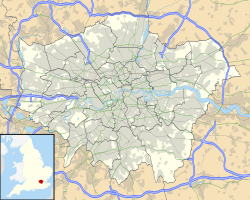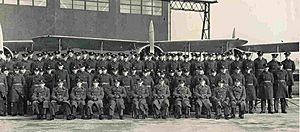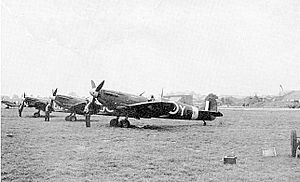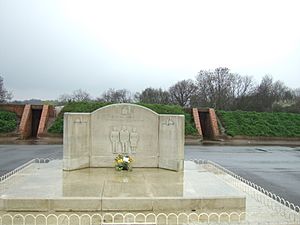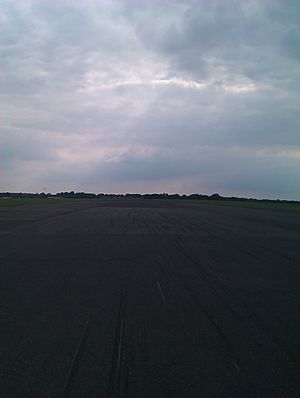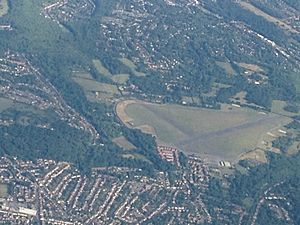RAF Kenley facts for kids
Quick facts for kids RAF Kenley
|
|||||||||
|---|---|---|---|---|---|---|---|---|---|
| Kenley, Croydon, Greater London in England | |||||||||

Supermarine Spitfire Mk V of No. 350 (Belgian) Squadron at RAF Kenley during the Second World War.
|
|||||||||
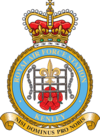
Nisi dominus pro nobis
(Error: {{language with name/for}}: missing language tag or language name (help)) |
|||||||||
|
Shown within Greater London
|
|||||||||
| Coordinates | 51°18′13″N 000°05′42″W / 51.30361°N 0.09500°W | ||||||||
| Type | Royal Air Force station | ||||||||
| Area | 49 hectares | ||||||||
| Site information | |||||||||
| Owner | Ministry of Defence (MOD) | ||||||||
| Operator | Royal Air Force | ||||||||
| Controlled by | No. 22 Group | ||||||||
| Condition | Open | ||||||||
| Site history | |||||||||
| Built | 1917 | ||||||||
| In use | 1917–1978 | ||||||||
| Fate | Retained by the MOD and used for gliding, some parts of airfield sold for residential redevelopment. | ||||||||
| Garrison information | |||||||||
| Occupants | No. 615 Volunteer Gliding Squadron | ||||||||
| Airfield information | |||||||||
| Identifiers | ICAO: EGKN, WMO: 03781 | ||||||||
|
|||||||||
RAF Kenley was an important airfield in England. It was first used by the Royal Flying Corps during World War I and later by the Royal Air Force (RAF) in World War II. Located near Kenley, Surrey, it played a key role in defending London during the Battle of Britain. Today, the site is still used by the Ministry of Defence as Kenley Airfield.
Contents
The History of RAF Kenley
RAF Kenley became very active in 1917. It continued to be a busy airfield until 1959, when the RAF's Fighter Command left. Today, it is home to the 615 Volunteer Gliding Squadron (VGS). This squadron is part of the RAF's 2 Flying Training School.
Preparing for World War II
In August 1939, work began to get RAF Kenley ready for new, powerful aircraft. These included Hurricanes, Spitfires, and Blenheims. Old hangars from World War I were taken down. Two concrete runways were built, along with paths for planes and special shelters to protect aircraft from explosions. More fuel storage and an armoury (a place for weapons) were also added. Most of this construction was finished by early 1940.
RAF Kenley's Role in World War II
During World War II, RAF Kenley was one of three main fighter airfields. The other two were Croydon and Biggin Hill. These three stations were vital for protecting London from air attacks. They became very famous during the Battle of Britain, when they defended against the German Luftwaffe.
The Attack on August 18, 1940
RAF Kenley suffered its worst damage on August 18, 1940. This day is often called the "costliest" or "hardest" day of the Battle of Britain. On this day, the British lost 68 aircraft, and the Germans lost 69. At Kenley, two of the three remaining hangars were destroyed. Many other buildings and ten aircraft, including six Hurricanes, were also ruined. Six more planes, like a Spitfire and two Hurricanes, were damaged. The runways were badly damaged by bombs, making large holes. The control room for operations had to be moved to a safe, hidden place away from the airfield.
Famous Pilots at Kenley
Many brave and famous pilots served at RAF Kenley. One well-known pilot was 'Sailor' Malan, a top fighter pilot from South Africa. Another was Group Captain P.H. 'Dutch' Hugo. C. W. A. Scott, who won the MacRobertson Air Race, also served here. He was with No. 32 Squadron RAF from 1923 to 1926.
Later, the British ace JE "Johnnie" Johnson took command of the Canadian wing at Kenley in 1943. P/O Arthur Gerald Donahue, from the USA, was one of seven Americans who flew in the Battle of Britain. He flew with 64 Squadron from Kenley. Donahue was shot down on August 13, 1940, and was burned, but he returned to duty. He wrote about his experiences in a book called "Tally Ho! Yankee in a Spitfire."
Squadrons and Units at Kenley
Many different RAF squadrons and other units were based at Kenley during its active years. These units played a crucial role in defending the country.
Squadrons
- No. 1 Squadron RAF
- No. 3 Squadron RAF
- No. 13 Squadron RAF
- No. 17 Squadron RAF
- No. 23 Squadron RAF
- No. 24 Squadron RAF
- No. 32 Squadron RAF
- No. 36 Squadron RAF
- No. 39 Squadron RAF
- No. 46 Squadron RAF
- No. 64 Squadron RAF
- No. 66 Squadron RAF
- No. 80 Squadron RAF
- No. 84 Squadron RAF
- No. 88 Squadron RAF
- No. 91 Squadron RAF
- No. 95 Squadron RAF
- No. 108 Squadron RAF
- No. 110 Squadron RAF
- No. 111 Squadron RAF
- No. 116 Squadron RAF
- No. 165 Squadron RAF
- No. 207 Squadron RAF
- No. 229 Squadron RAF
- No. 253 Squadron RAF
- No. 258 Squadron RAF
- No. 302 Polish Fighter Squadron
- No. 312 (Czechoslovak) Squadron RAF
- No. 350 (Belgian) Squadron RAF
- No. 400 Squadron RAF
- No. 401 Squadron RAF
- No. 402 Squadron RAF
- No. 403 Squadron RAF
- No. 411 Squadron RCAF
- No. 412 Squadron RAF
- No. 416 Squadron RAF
- No. 421 Squadron RCAF
- No. 452 Squadron RAAF
- No. 485 Squadron RNZAF
- No. 501 Squadron RAF
- No. 600 Squadron RAF
- No. 602 Squadron RAF
- No. 611 Squadron RAF
- No. 615 Squadron RAF
- No. 616 Squadron RAF
- No. 661 Squadron RAF
- 4th Fighter Squadron (1942)
- 308th Fighter Squadron (1942)
Other Units
- No. 1 Communication Squadron RAF
- No. 1 Group RAF
- No. 2 Mechnical Transport Storage Unit
- No. 6 (Fighter) Group RAF
- No. 7 (Kenley) AAP
- No. 17 (Fighter) Wing RAF
- No. 17 (Fighter) Sector
- No. 56 Elementary and Reserve Flying Training School RAF
- No. 61 (Eastern) Group RAF
- No. 61 (Eastern Reserve) Group RAF
- No. 61 (Southern Reserve) Group RAF
- No. 61 Group Communication Flight RAF
- No. 61 Fighter Wing RAF
- No. 86 (Communications) Wing RAF
- No. 103 (Air Disarmament) Wing RAF
- No. 127 Airfield
- No. 143 Gliding School RAF
- No. 162 Gliding School RAF
- No. 409 Repair & Salvage Unit
- No. 419 (RCAF) Repair & Salvage Unit
- No. 615 Gliding School RAF became No. 615 Volunteer Gliding Squadron RAF
- No. 1335 Wing RAF Regiment
- No. 1336 Wing RAF Regiment
- No. 1957 Reserve AOP Flight RAF
- No. 1960 Reserve AOP Flight RAF
- No. 2704 Squadron RAF Regiment
- No. 2721 Squadron RAF Regiment
- No. 2729 Squadron RAF Regiment
- No. 2732 Squadron RAF Regiment
- No. 2738 Squadron RAF Regiment
- No. 2766 Squadron RAF Regiment
- No. 2820 Squadron RAF Regiment
- No. 3201 Servicing Commando
- No. 3207 Servicing Commando
- Fighting Area
- Kenley AAP
- Photographic Experimental Section/Station
- Signal Co-operation Flight
- Surrey Hills Gliding Club
- University of London Air Squadron
RAF Kenley Today: A Historic Site
Even though many buildings are gone, RAF Kenley is considered the best-preserved World War II fighter airfield. The control tower was taken down after a fire in 1978, and the last hangar was also removed. However, the runway still looks like it did during the war. In 2000, English Heritage said Kenley was "The most complete fighter airfield associated with the Battle of Britain to have survived." The councils of Croydon and Tandridge have made the airfield a Conservation Area to protect it.
Eleven of the original 12 E-shaped blast pens are still there, either partly or fully. These were shelters for ground crew and aircraft. One blast pen, which is behind the RAF memorial, has been fully restored. Since 2004, these structures have been protected as Scheduled Monuments.
Current Use of the Airfield
The airfield is still used today by 615 VGS (Volunteer Gliding Squadron). They fly military Viking T.1 gliders. This squadron offers gliding chances and training to members of the Royal Air Force Air Cadets.
The land that includes the taxiway and inside it belongs to the Ministry of Defence. However, the area outside this is common land. This means people can still walk in the woods and on the common land around the airfield. You can also visit the Wattenden Arms pub, which is very close to the airfield. Pilots were said to have liked this pub during the war. The pub is decorated with pictures and items related to the airfield's history.
Remembering the Heroes
A part of the former air station is kept as a tribute to the service members from the Commonwealth and Allied fighter squadrons. These brave individuals fought alongside the RAF. A memorial was unveiled on August 19, 2000, in a former aircraft parking area within one of the blast pens. It honors the Royal Air Force and allied air forces.
The inscription on the memorial reads: RAF Kenley Tribute in Honour of All Personnel Who Served Here 1917–1959.
At the bottom of the memorial, there is a famous quote from Winston Churchill about the Battle of Britain: Never in the field of human conflict, has so much been owed by so many to so few — Winston Churchill 1942.
The airfield is also next to the headquarters of 450 Kenley Air Cadets.
The Ministry of Defence and Surrey Hills Gliding Club still use the airfield for glider aircraft. However, regular powered aircraft are not allowed to use it anymore.


